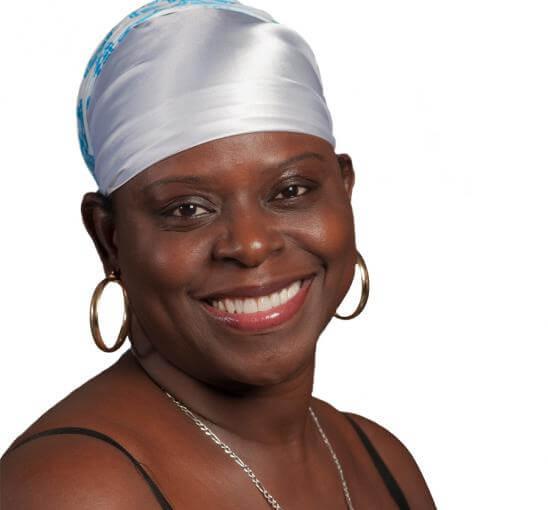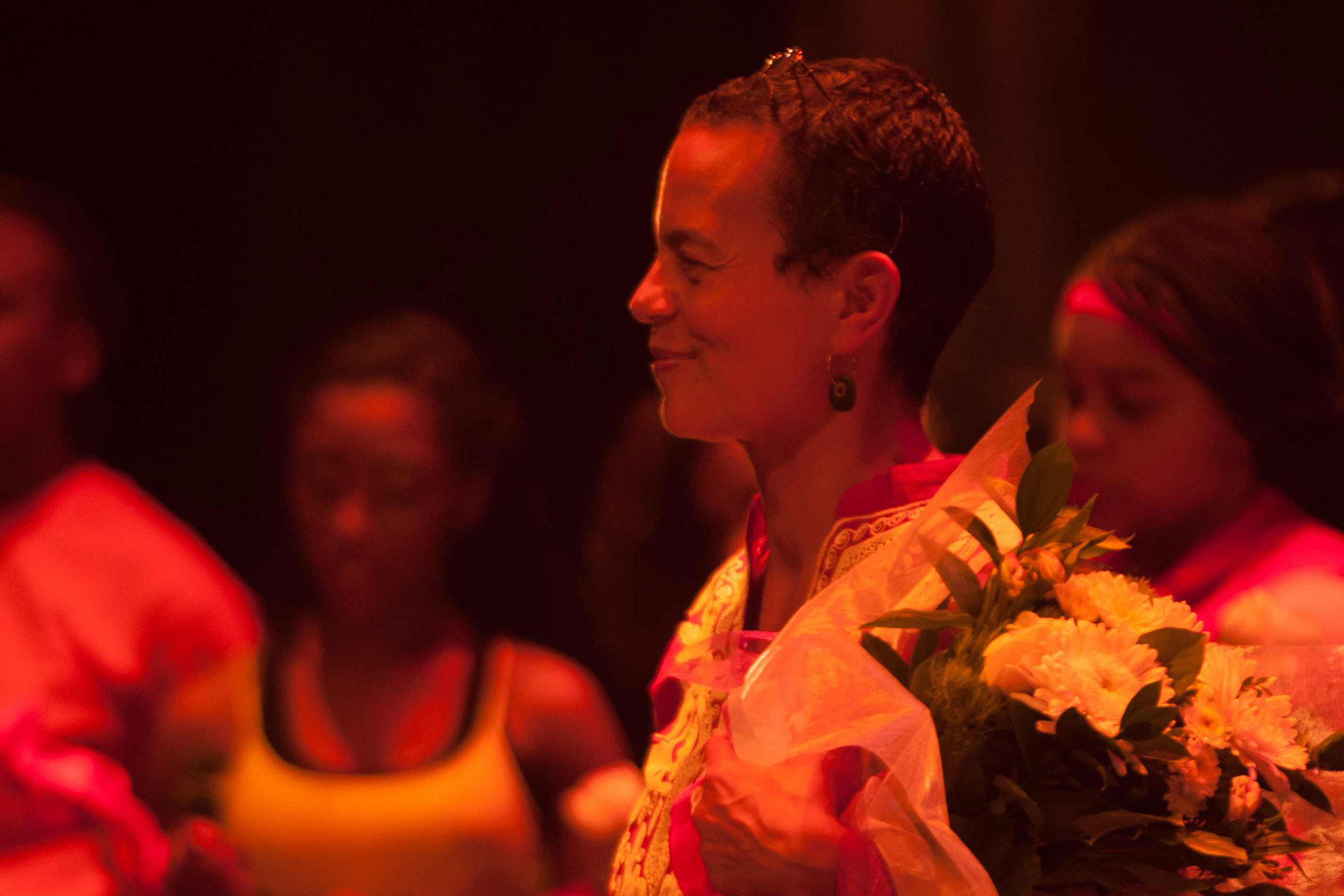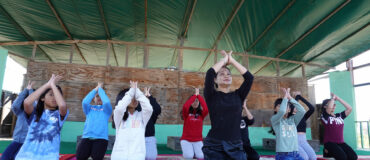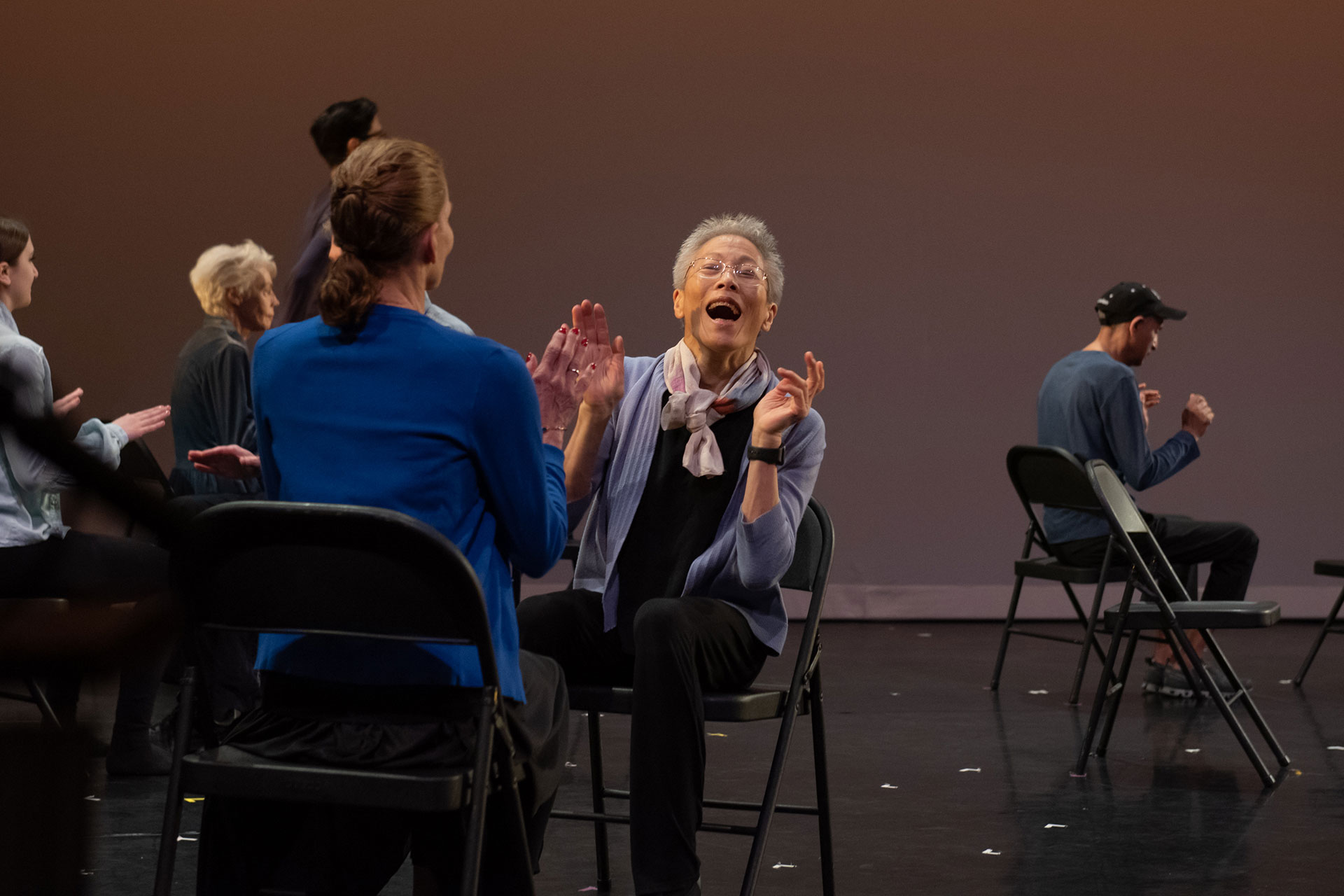Dance Is the Weapon for Social Justice
Vanessa Sanchez, Danys “La Mora” Pérez Prades, and Ana María Alvarez
By Umi Vaughan, Ph.D.
Editor’s note: This article is one of 11 in a series examining the creative work of 31 dance artists funded by Dance/USA Fellowship to Artists, generously supported by the Doris Duke Charitable Foundation. These artists’ practices are embedded in social change as they work in multiple dance forms in communities across the country.

In Full Still Hungry, Ana María Alvarez delivers the final monologue about food justice. “Food,” she said, “is not just the material I put in my body to sustain life — but a web of relationships, histories, choices, decisions that impact the world around us.” Courtesy A.M. Alvarez
Vanessa Sanchez, Danys “La Mora” Pérez Prades, and Ana María Alvarez are three dynamic artists from distinct origins and eras. Yet they attack the cultural now in similar ways through dance. Rooted in rhythms and movement traditions of the African Diaspora, they center vernacular and sometimes sacred culture on stage. They inhabit multiple worlds of movement and spoken language. And they tell subaltern stories, exposing audiences to new viewpoints and voices. As Dance/USA Artist Fellows, they exemplify strong ties to tradition, thirst for experimentation and innovation, and reflect a commitment to excellence and activism. Each in their own way wields dance as a weapon for social justice.
ILLUMINATING FORGOTTEN HISTORIES
Vanessa Sanchez fell in love with dance at the age of four and by the time she was a teenager she understood dance was the center of her life. Perhaps she chose to dance rather than play baseball, of all things, distinguishing between a joyful pursuit and a life passion. The sounds of Santana and other Latin rock bands seasoned the atmosphere in her childhood home in the San Francisco Bay Area. She wants to center voices of indigenous, Chicana women of color by featuring dance narratives and movement vocabulary that bubble up from deep within communities and explode on stage to delight and challenge audiences.

Vanessa Sanchez is a Chicana Native dancer who places traditional percussive dance forms in contemporary contexts, creating rhythmic and cross-cultural dialogues in new settings. Her work in the San Francisco Bay Area includes community arts education focusing on multicultural dance forms. Photo: Alexa Treviño
Sanchez names Afro-Brazilian choreographer Tania Santiago, Afro-Cuban choreographer Susana Arenas Pedroso, and Mexican son jarocho master Laura Rebolloso as her main mentors. Son jarocho, with its percussive approach to various string instruments, antiphonal singing, and syncopated footwork, highlights the sometimes-forgotten African influence in Mexican culture. From these instructors she learned to consider her contemporary work as an extension of long traditions of dance as a part of everyday life and resistance to oppression. Sanchez takes the notion of dance as sacred — even revolutionary — practice and applies it to myriad unexpected contexts. Her recent piece entitled Pachuquismo weaves African-American tap and African-tinged zapateado (hoofing) from Mexico’s Gulf Coast. Sanchez invokes commonalities between these distinct music and dance languages to illuminate and sound off about the history of the pachuco subculture, where zoot-suited Chicano men bonded and flourished in mid-20th-century Los Angeles. With their own special style — including baggy zoot suits, a slang known as Caló, and a unique swagger — the pachucos expressed a unique identity that was neither white nor mainstream U.S. American. But also, strictly speaking it was not Mexican either. “People forget that women — pachucas — played an important part!”1 Sanchez reminds us of these contributions emphatically with bad-ass, zoot-suited women from her troupe La Mezcla (the mix) tap dancing a cappella, to jazz and son jarocho. The work is at once a creative interplay and comparison among related African Diaspora genres (including from Mexico), and an intense narrative about the experiences of strong women during a fascinating moment in Chicano/U.S. history.

Exploring the Mexican-American pachuco culture — the 1940s Zoot suit era — Sanchez uses tap, zapateado, live jazz and Veracruz’s son jarocho. Her female cast challenges the dominant male culture in Pachuquísmo, delving into cultural history and capturing rhythms and styles that were frequently disparaged. Photo: Anthony Thornton
Although the non-profit arts funding world is new terrain for her, Sanchez recognizes the importance of visibility and representation therein. “Having our stories present on stage is huge,” she says. “But so is access to boardrooms and the decision-making power to help shape and guide the arts field.” She sees her Dance/USA Artist Fellowship experience as a chance to build audience and donor support for her company and for other women of color choreographers.
SUSTAINING AFRO-CUBAN LEGACIES
Danys Pérez Prades, known affectionately as “La Mora,” is from Santiago de Cuba, the island’s second colonial capital (after Baracoa and before Havana) and still the principal city of the eastern region. Her nickname means the Mooress, a reference to the history of Moorish or North African occupation of Spain as early as the 7th century, and resultant linguistic and cultural influences that subsequently reached Cuba and other Spanish colonies. As her name hints, Pérez Prades’s work is built on an old, multi-layered foundation created by complex histories. In her opinion, “Dancers are born.” It is something from which you cannot escape. “Training happens later and molds them,” she adds. “But true dancers are born with it in their soul. I was born to dance.”

Danys “La Mora” Pérez is not only invested in preserving Afro-Cuban dances, but in spreading knowledge and power of culture, art and history through New York classes and educational trips to Cuba. Her Siete Mares tells the story of Yemayá, powerful ocean goddess. Photo: Steven Pizano
Pérez Prades grew up surrounded by music in her home and in her neighborhood, called José Martí. Her father was a singer. As early as six years old she participated in dance-based cultural events put on by community organizations like La Casa de Cultura or the Committee for the Defense of the Revolution (CDR). There was even a time when she wanted to become a lawyer, “in order to defend justice.” But eventually she surrendered to her true calling: still fighting for justice, but through dance. She went on to grace stages and teach Cuban dance the world over as principal dancer of Ballet Folklórico Cutumba, Cuba’s oldest folkloric dance company.2 This role brought her special recognition and an invitation from African Diaspora dance legend Katherine Dunham to deliver a workshop series at Dunham’s famous studio in East St. Louis. Pérez Prades was a guest and received private lessons in Dunham’s home. “She taught me about breathing and reaffirmed for me the value of the Haitian-Cuban dances I had been doing my whole life.”
Santiago molded La Mora with its mixture of all of Cuba’s Spanish, West and Central African, as well as Franco and Anglophone Caribbean heritage. Called the Heroic City — ciudad héroe — Santiago is the birthplace of much of Cuba’s revolutionary history. Artistically Pérez Prades, like her city, is bold. Her work explores the legacy of the Yoruba/Lucumí, Congo, and Dahomey nations, which were transported in chains and whose cultures reimagined themselves on the island through sheer force of will and ingenuity. Cleverness, beauty, fusion, and fierce innovation are on full display in the oricha dances for Eleguá, Changó, Ochun, Yemayá, and other deities; the Palo-Congo war dances, creole rumba courtships and competitions; and Cuban-Haitian vodú celebrations she presents on stage. Lucumí, Kikongo, Dahomey/Fon, bozal Spanish spoken by enslaved Africans, and Kreyol Ayisyen are the languages that rise up over the drums.

Danys “La Mora” Pérez studied Afro-Cuban and Afro-Haitian dance as a child in Santiago de Cuba. At 13 she was invited to perform with the national folkloric company Cutumba. Today Pérez is a master teacher, choreographer and ethnologist lauded as a foremost interpreter of Afro-Cuban dance. Courtesy: D. Pérez
The current iteration of her troupe Oyu Oro, founded in New York City in 2005, continues a half-century-plus tradition of Cuban folkloric companies performing sacred rhythms, songs, dances, and glimpses of reenacted ritual on stage. For some this re-contextualization of sacred performance traditions challenges accepted values. Others find it is a way to honor beautiful traditions that had for centuries been maligned and considered taboo by governments, authorities, and elites.3 Like one of my mentors, master batá drummer Carlos Aldama, founding member of Conjunto Folklórico Nacional de Cuba, Cutumba’s Havana counterpart, Pérez Prades presents these dances with a deep sense of respect, as a way to teach about the roots and nuances of Cuban culture. “I teach culture, art, and history, not religion,” she clarifies. But by sharing onstage even a bit of the magic that happens in religious ceremony, she exposes audiences to the healing power of these traditions, creating space for viewers to be touched, renewed, transformed through dance. She finds the need for dance that foments unity, honesty, justice, and healing to be very strong during the COVID-19 crisis, social justice upheaval, and worldwide outcry sparked in part by the killings of Breonna Taylor, George Floyd, and so many others at the hands of police.
EMBRACING ONE’s WHOLE SELF
Ana María Alvarez is the artistic director of CONTRA-TIEMPO, a bold, multilingual activist dance-theater company that blends Afro-Cuban movement, from oricha lore and rumba to son, salsa, and casino, mixed liberally with hip-hop, house, stepping, poetry, and story-telling. Alvarez cannot remember a time when she didn’t love dance. She comes from a Cuban family and her grandfather was a great bailador — dancer. Women still literally form a line to cut a rug with him, she says. She is a child of the 1990s, when homemade choreographies with one’s crew of friends were standard preparation for any school dance or house party. She also studied ballet, jazz, and tap formally from the age of five. As a teen she had the bitter experience so common for young dancers of color: their ballet instructor praises their talent and drive, but regretfully informs them that their overly curvy body type just won’t work for the style. The disillusionment she felt would affect her later approach to dance, choreography, and activism with an emphasis on claiming space.

For Alvarez, salsa can express social resistance, particularly to the U.S. immigration system. In 2005, salsa became the impetus for her to found CONTRA-TIEMPO Urban Latin Dance Theater, which centers overlooked stories from dancers and communities in Los Angeles. Photo: Brandt Brogan
Alvarez points to Katherine Dunham’s multifaceted work as a dancer, choreographer, anthropologist, and activist as a major inspiration. She also cites choreographers Dr. Eleanor Gwynn, Liz Lerman, and Jawole Willa Jo Zollar as key mentors. It was with the latter’s group, Urban Bush Women, that Alvarez had perhaps her biggest breakthrough to self-discovery. At UBW’s then-month-long Summer Leadership Institute: A New Dancer for a New Society in Tallahassee, Fla. — where participants learned about building community as a mechanism for social change, got down in juke joints, and trained for seven-plus hours per day — Alvarez realized that she needed to bring her whole self in order to really dance. At that moment she resolved to embrace her full figure, collectivist political vision, multilingualism, and dance fiercely with all of it, fully embodying the in-between.
She acknowledges the difficulty of sustaining a community-based arts organization and emphasizes that it has become exponentially harder during the COVID-19 pandemic. The current economic downturn, with canceled shows, tours, residencies and other opportunities, has made her reflect on the very nature and limitations of the “professional dance company” model with its reliance on corporate and non-profit funders, donors, and ticket revenue. For groups like hers, which emerge from and represent marginalized communities, she sees this format as less than ideal. Alvarez is thinking actively about what other institutional shapes or structures could best serve her vision of “transforming the world through dance.” Despite challenges, community engagement remains a priority and new choreography is in the works. Although things seem dark “inside the crisis,” Alvarez affirms that “there will be a future.” She is excited to be an artist in these times because “artists inhabit the imagination” and push society toward building a future that aligns with the people’s values. “The sore is finally open,” she says, “which can allow for healing to happen.”
These three dynamic artists — Vanessa Sanchez, Danys “La Mora” Pérez Prades, and Ana María Alvarez — transmit important messages for our time. Each is lovingly engaged in the fight to improve our world. Dance is their weapon.
__________
1 See The Woman in the Zoot Suit: Gender, Nationalism, and the Cultural Politics of Memory by Catherine Ramirez, one of the advisors for Pachuquismo (Duke University Press 2009).
2 Cuba’s oldest folkloric dance company, founded in Santiago de Cuba in 1957 (Interview with La Mora).
3 For more on staging sacred dance, see Divine Utterances: The Performance of Afro-Cuban Santería by Katherine Hagedorn (Smithsonian Books 2001).

Umi Vaughan is a scholar/artist who conducts research, creates photographs and performances, and publishes work that examines the evolution and meaning of music/dance traditions across the African Diaspora. He holds a Ph.D. in Cultural Anthropology from the University of Michigan and is currently associate professor of Africana Studies at California State University Monterey Bay. Dr. Vaughan is the author of Carlos Aldama’s Life in Batá: Cuba, Diaspora, and the Drum (Indiana University Press) and Rebel Dance, Renegade Stance: Timba Music and Black Identity in Cuba (University of Michigan Press).
Please visit the artists’ websites: Ana Maria Alvarez, Danys “La Mora” Pérez, and Vanessa Sanchez. Readers may read and print a PDF version of this article here. A Spanish translation of this article may be found here. Readers may visit and share this article on Medium here. Find more information on the DFA Article Series here and more information on Dance/USA Fellowships to artists here.
____
We accept submissions on topics relevant to the field: advocacy, artistic issues, arts policy, community building, development, employment, engagement, touring, and other topics that deal with the business of dance. We cannot publish criticism, single-company season announcements, and single-company or single artist profiles. Additionally, we welcome feedback on articles. If you have a topic that you would like to see addressed or feedback, please contact communications@danceusa.org.
Disclaimer: Opinions expressed in guest posts do not necessarily represent the viewpoints of Dance/USA.




